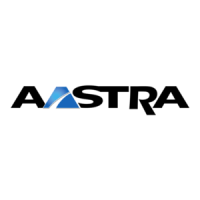AMT/PTD/PBX/0020/2/4/EN 01/2007 Page 91
The state of the jumpers can be viewed via MMC: Menu 3.2.4
Figure 4-18: Status of ISDN card jumpers (Menu 3.2.4)
Note:
The jumper status of LD4NX cards in LD4X mode equipped in the PBX are also
displayed (in this example, the card is equipped in slot 1-01).
4.7.6 Connecting base stations
Each base station is connected to an ISDN S0 (BRI) interface of a UCT-S/UCTS-12/UCT-C card,
and uses two pairs: 1 transmit pair and 1 receive pair.
If several base stations are connected to the S0 accesses of a first generation UCT1-S/UCT1S-
12/UCT-C card or if one base station is connected to one S0 access of an LD4, LD4NX card and
another to an integrated S0 access of a first generation UCT1-S/UCT1S-12/UCT-C card, a third
pair needs to be wired for synchronization (pins 1 and 2 of the base station RJ45 connector) (see
section 4.8).
The S0 integrated accesses of seconde generation UCT2-S/UCT2S-12/UCT2-C cards and the
S0 integrated accesses of third generation UCT3-S/UCT3S-12 cards manage the
synchronisation by bit M frame S.
ISDN BOARD SWITCHES STATUS
SLOT TYPE DIREC/TG SYNC REMO-SUPL
--------------------------------------------
0-02-00 S0 300 YES YES
0-02-01 DECT BASE TG0 YES YES
0-02-02 T0 FT0-ETSI YES NO
0-02-03 T0 FT0-ETSI YES NO
1-01-00 S0 310 YES 40V
1-01-01 S0 311 YES NO
1-01-02 S0 312 YES NO
1-01-03 S0 313 YES 40V

